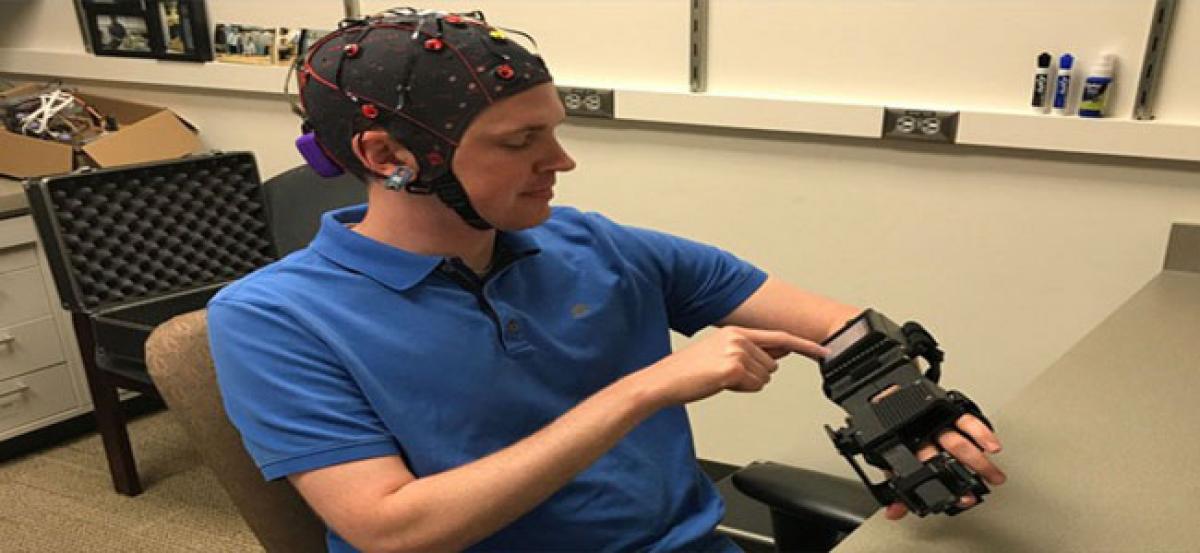Live
- UpStudy: The Smart Solution for Homework Hassles
- Actress Rithika and models inaugurate Sutraa Lifestyle Exhibition
- Loud campaign
- Faculty students celebrated english literature day in Government Degree College
- Huge fire accident.. Shops of street vendors burnt in the fire
- Pawan Kalyan promises to protect the coastal area from sea erosion
- EC Transfers Two Senior IPS Officers in AP ahead of Elections
- DMK analysis predicts victory for INDIA bloc in TN but concedes gains for BJP and NDA too
- India showcasing innovative technologies at World Energy Congress
- IPL 2024: Mitchell comes in for Ravindra as Lucknow opt to bowl first against Chennai
Just In

Stroke patients who learned to use their minds to open and close a device fitted over their paralyzed hands gained some control over their hands, according to a new study from Washington University School of Medicine in St. Louis. By mentally controlling the device with the help of a brain-computer interface
Stroke patients who learned to use their minds to open and close a device fitted over their paralyzed hands gained some control over their hands, according to a new study from Washington University School of Medicine in St. Louis. By mentally controlling the device with the help of a brain-computer interface, participants trained the uninjured parts of their brains to take over functions previously performed by injured areas of the brain, the researchers said.
“We have shown that a brain-computer interface using the uninjured hemisphere can achieve meaningful recovery in chronic stroke patients,” said Eric Leuthardt, MD, a professor of neurosurgery, of neuroscience, of biomedical engineering, and of mechanical engineering & applied science, and the study’s co-senior author. The study is published May 26 in the journal Stroke.
Stroke is the leading cause of acquired disability among adults. About 700,000 people in the United States experience a stroke every year, and 7 million are living with the aftermath. In the first weeks after a stroke, people rapidly recover some abilities, but their progress typically plateaus after about three months.
“We chose to evaluate the device in patients who had their first stroke six months or more in the past because not a lot of gains are happening by that point,” said co-senior author Thy Huskey, MD, an associate professor of neurology at the School of Medicine and program director of the Stroke Rehabilitation Center of Excellence at The Rehabilitation Institute of St. Louis. “Some lose motivation. But we need to continue working on finding technology to help this neglected patient population.”
David Bundy, PhD, the study’s first author and a former graduate student in Leuthardt’s lab, worked to take advantage of a quirk in how the brain controls movement of the limbs. In general, areas of the brain that control movement are on the opposite side of the body from the limbs they control.
But about a decade ago, Leuthardt and Bundy, who is now a postdoctoral researcher at University of Kansas Medical Center, discovered that a small area of the brain played a role in planning movement on the same side of the body. To move the left hand, they realized, specific electrical signals indicating movement planning first appear in a motor area on the left side of the brain.
Within milliseconds, the right-sided motor areas become active, and the movement intention is translated into actual contraction of muscles in the hand. A person whose left hand and arm are paralyzed has sustained damage to the motor areas on the right side of the brain. But the left side of the person’s brain is frequently intact, meaning many stroke patients can still generate the electrical signal that indicates an intention to move. The signal, however, goes nowhere since the area that executes the movement plan is out of commission.

© 2024 Hyderabad Media House Limited/The Hans India. All rights reserved. Powered by hocalwire.com







